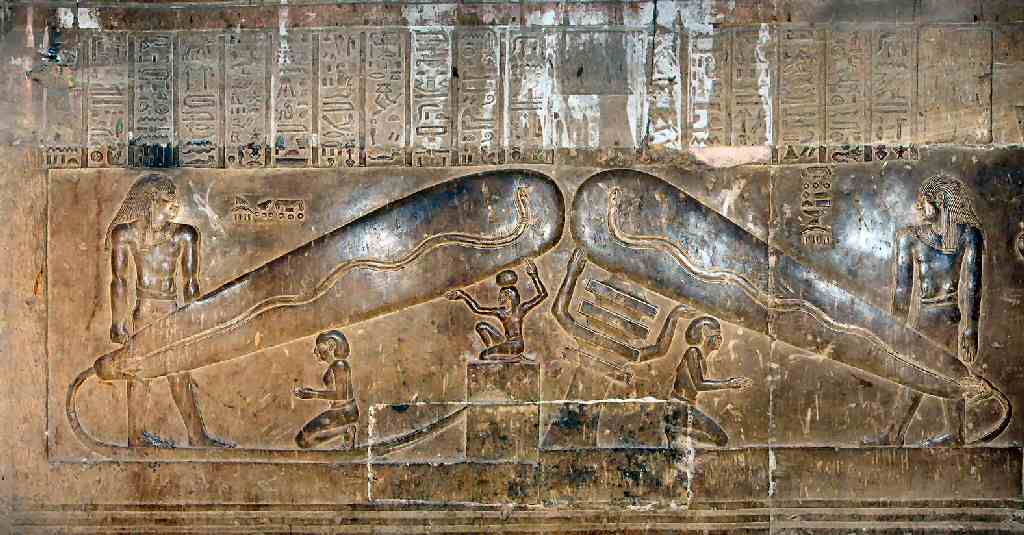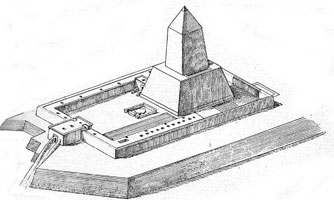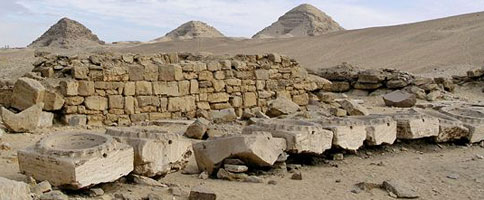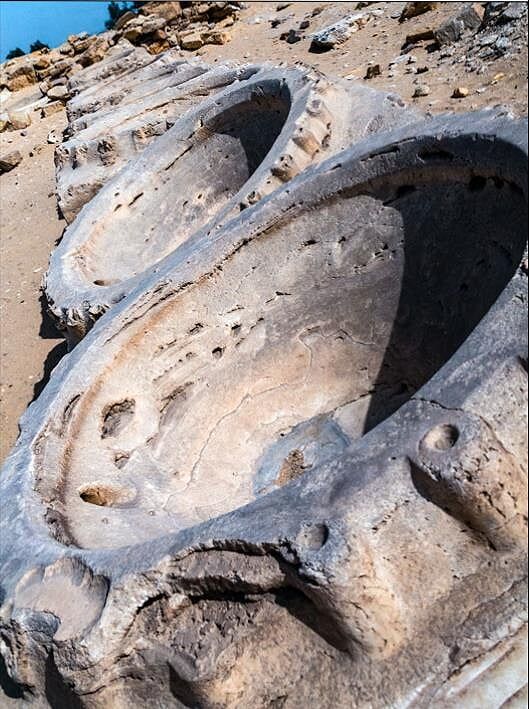It looks like you're using an Ad Blocker.
Please white-list or disable AboveTopSecret.com in your ad-blocking tool.
Thank you.
Some features of ATS will be disabled while you continue to use an ad-blocker.
share:
I'm gonna Occam's razor the poop out of this.
Dawg, these were obviously made by man.
Which means, almost assuredly, these are fermentation related.
Single hole in the bottom, designed to collect heat, simple, yet big, and would be a fine base piece of equipment for even modern day mountain shiners. Throw a copper top on these bad boys and let the sun do it, or throw a roaring fire underneath and get the party started.
These were probably cranking out solar heating to ferment wine, mead, figs, something along those lines. Come get some of this ancient Nile Sacrament, boiiiii yeet~!
Dawg, these were obviously made by man.
Which means, almost assuredly, these are fermentation related.
Single hole in the bottom, designed to collect heat, simple, yet big, and would be a fine base piece of equipment for even modern day mountain shiners. Throw a copper top on these bad boys and let the sun do it, or throw a roaring fire underneath and get the party started.
These were probably cranking out solar heating to ferment wine, mead, figs, something along those lines. Come get some of this ancient Nile Sacrament, boiiiii yeet~!
originally posted by: Archivalist
I'm gonna Occam's razor the poop out of this.
Dawg, these were obviously made by man.
Which means, almost assuredly, these are fermentation related.
Single hole in the bottom, designed to collect heat, simple, yet big, and would be a fine base piece of equipment for even modern day mountain shiners. Throw a copper top on these bad boys and let the sun do it, or throw a roaring fire underneath and get the party started.
These were probably cranking out solar heating to ferment wine, mead, figs, something along those lines. Come get some of this ancient Nile Sacrament, boiiiii yeet~!
Or maybe they where using it to generate electricity.. ;-)


originally posted by: KansasGirl
a reply to: purplemer
Each bowl has a hole on the outside, slightly below the rim, so I would assume for drainage out of the bowls.
Wine anyone? I can imagine them stomping around on grapes and then adding water slowly to bring the juice to the top.
Seems the most obvious use of such a bunch of vessels like this.
edit on 30-12-2018 by charlyv because: c
Perhaps each one of those bowls had a polished gold type parabolic mirrored bowl insert. This was angled correctly by the temple chief to direct it's
rays onto the monolith. The angle and polished surface of the parabolic type bowl mirrors would be protected from dust and interference by a secured
dome structure (early glass dome perhaps)?
Just a thought?
Just a thought?
2 things strike me:
The top face looks very smooth and worn down compared to all other surfaces.
They don't appear carved but rather cast from some type of geopolymer.
The top face looks very smooth and worn down compared to all other surfaces.
They don't appear carved but rather cast from some type of geopolymer.
a reply to: purplemer
Maybe they had mirrors or something inside, then focused the reflections all on the same spot, multiplying their power. And whatever was on that spot was the solar panel.
Like that solar tower they made, I cant remember where, but they do the same thing, a large array of mirrored bowls all aimed at the top of a tower which is a big solar panel that can absorb the power of the sun times 500 or so. I think they power a nearby town, but I havent heard if it makes their power bill any cheaper or if it's just considered more green or what.
Maybe they had mirrors or something inside, then focused the reflections all on the same spot, multiplying their power. And whatever was on that spot was the solar panel.
Like that solar tower they made, I cant remember where, but they do the same thing, a large array of mirrored bowls all aimed at the top of a tower which is a big solar panel that can absorb the power of the sun times 500 or so. I think they power a nearby town, but I havent heard if it makes their power bill any cheaper or if it's just considered more green or what.
originally posted by: purplemer
This is a depiction of the Sun Temple of Niuserre. It may well be a lot older than that too. It is said by Egyptologists that its foundations may be far older.
Whilst looking through images I came across an interesting stone artefact.
Convention would have us believe that these where sacrifical bowls for blood. Although I have not found the artefact repeated nor was there any evidence to support this theory.
It has been proposed that this area was a slaughterhouse for offerings to be made in the temple. However, there is no sign of the cones shaped blocks used to tether sacrificial beasts which were found in the "Sanctuary of the Knife" of the pyramid complex of Neferefre and no trace of animal bones or flint from knives were found here so this has been questioned
www.ancientegyptonline.co.uk...
Now i came across another image of the same objects and this one got me thinking.
These look like they where meant to have some kind of lid bolted over. If this is the case could we not be looking at very old type of solar panel. It Remember this is the Sun Temple.
Purely artifice. Do you expect that next to the wall of rock is a semblence of accord? Not even real. Those plaster caps are from some movie sept. lol
The only son shidning on that one is a just that collector of those that believe in solar power. Nothing real about that. d
First off all, not related, that drawing of the obelisk in that particular setting reminds me of a Lingam, only much larger then ussually found in
India.
As for the bowls, I am inclined to agree with the geopolymer theory (based on visual clues like air bubble like cavities and apparent layering). It also looks as if the bowls were coated with a layer of grayish material. Perhaps that layer was a more durable material to counter wear and tear, or something similar to a teflon coating on a frying pan.
I doubt if the layers are natural strata, because it looks like the “coating” is also at the bottom of the concave, I could be wrong. It is also totally my personal opinion that, to me, it looks as if the bowls recieved punishing treatment during operation, could be mechanical or perhaps they had to contain corrosive liquids, or with extreme temperatures.
When I go the way of the my own brand of occams razor, the bowls are probably part of some sort ornamental cascading water structure. The holes along the rim are probably decorative, or merely to hold something in place temporarily, but not for bolting something down, for that the holes appear to be too shallow. Perhaps they were to guide and keep in place a lid or a cilindrical sleave/stackable rims, that can be easily be removed after some process.
Again, this is pure speculation on my part, so don’t phage the messenger!
As for the bowls, I am inclined to agree with the geopolymer theory (based on visual clues like air bubble like cavities and apparent layering). It also looks as if the bowls were coated with a layer of grayish material. Perhaps that layer was a more durable material to counter wear and tear, or something similar to a teflon coating on a frying pan.
I doubt if the layers are natural strata, because it looks like the “coating” is also at the bottom of the concave, I could be wrong. It is also totally my personal opinion that, to me, it looks as if the bowls recieved punishing treatment during operation, could be mechanical or perhaps they had to contain corrosive liquids, or with extreme temperatures.
When I go the way of the my own brand of occams razor, the bowls are probably part of some sort ornamental cascading water structure. The holes along the rim are probably decorative, or merely to hold something in place temporarily, but not for bolting something down, for that the holes appear to be too shallow. Perhaps they were to guide and keep in place a lid or a cilindrical sleave/stackable rims, that can be easily be removed after some process.
Again, this is pure speculation on my part, so don’t phage the messenger!
edit on 31-12-2018 by 2Faced because: Happy New Year!
a reply to: 2Faced
No, I like it.
Perhaps the bowls were used as some form of mixing device for hallucinogenic type liquids which could be served or decanted through those holes. The holes being higher up as the liquid was made from other moist solids they didn't want blocking the flow? (Just taking a stab here)......you know worshipers and hallucinogens etc. You just never know??
No, I like it.
Perhaps the bowls were used as some form of mixing device for hallucinogenic type liquids which could be served or decanted through those holes. The holes being higher up as the liquid was made from other moist solids they didn't want blocking the flow? (Just taking a stab here)......you know worshipers and hallucinogens etc. You just never know??
In the second pic of the bowl shaped things.. there appears to be a ring of cruddy stuff left behind near the rim of at least a couple of the bowls.
It would be neat to have this crud analyzed to see what could be gleaned from it.
I've no idea how alabaster basins could be used to harvest solar power.....anyway, this is what wiki has to say about them:
Along the east wall of the courtyard are a set of nine circular alabaster basins.[3] It has been theorized that there were originally ten basins. Some scholars believe these basins were used to collect blood from animal sacrifice. To support this hypothesis, they point to evidence of grooves cut into the stone floor of the courtyard that may have been used to drain away the blood. Other researchers, however, think that the basins were probably only symbolic, or decorative, since no knives or other equipment related to sacrifice have been discovered in the area. It has also been hypothesized that these basins were used as leveling devices for large areas, linked together and filled with water to provide a common point of reference. Further examination, however, is required to determine the exact role of the alabaster bins.
a reply to: FatherLukeDuke
The bowls are calcite, this video is an excellent overview of Abu Ghorub where the bowls are located showing the quartzite altar:
calcite possibly alabaster bowls
The bowls are calcite, this video is an excellent overview of Abu Ghorub where the bowls are located showing the quartzite altar:
calcite possibly alabaster bowls
edit on 1-1-2019 by ThatDidHappen because: (no reason
given)
originally posted by: charlyv
originally posted by: KansasGirl
a reply to: purplemer
Each bowl has a hole on the outside, slightly below the rim, so I would assume for drainage out of the bowls.
Wine anyone? I can imagine them stomping around on grapes and then adding water slowly to bring the juice to the top.
Seems the most obvious use of such a bunch of vessels like this.
BOOM.
And CharlyV and KansasGirl tag team for the win.
They are hydroponic bowls for decorative lotus plants at temple
a reply to: FatherLukeDuke
For the love of god anything but Wiki. Its like trying to glean the facts from RT, CNN or the BBC. Its fully controlled and used as a tool of propaganda..
Best thing to do is use your noggin.
I've no idea how alabaster basins could be used to harvest solar power.....anyway, this is what wiki has to say about them:
For the love of god anything but Wiki. Its like trying to glean the facts from RT, CNN or the BBC. Its fully controlled and used as a tool of propaganda..
Best thing to do is use your noggin.
originally posted by: punkinworks10
They are hydroponic bowls for decorative lotus plants at temple
Those lotus plants where more than decorative..
Traditionally used for third eye activation a psychoactive of sorts. Funny how many of the gods world wide are depicted standing on a lotus flower.
new topics
-
Matthew Livelsberger said he was being followed by FBI
The Gray Area: 2 hours ago -
How the Sikhs Deal with Muslim Grooming Gangs – Tommy Robinson
Social Issues and Civil Unrest: 3 hours ago -
Paranoid Liberals Believe U.S. Service Members are More Dangerous than Illegal Aliens.
Social Issues and Civil Unrest: 4 hours ago -
The 119th Congress has Officially Opened for Business
Mainstream News: 5 hours ago -
Here we again... CHINA having mass outbreak of something
Diseases and Pandemics: 5 hours ago -
Flee from idolatry
Religion, Faith, And Theology: 10 hours ago -
FIEND SLASHED: Sara Sharif’s killer dad ‘has neck & face sliced open with jagged tuna tin lid
Mainstream News: 11 hours ago
top topics
-
Musk calls on King Charles III to dissolve Parliament over Oldham sex grooming gangs
Mainstream News: 12 hours ago, 14 flags -
The Why Files Lacerta Reveals the Truth of our Creation
Aliens and UFOs: 13 hours ago, 11 flags -
Matthew Livelsberger said he was being followed by FBI
The Gray Area: 2 hours ago, 10 flags -
FIEND SLASHED: Sara Sharif’s killer dad ‘has neck & face sliced open with jagged tuna tin lid
Mainstream News: 11 hours ago, 10 flags -
Grenfell Tower Fire revisited
Mainstream News: 12 hours ago, 9 flags -
The 119th Congress has Officially Opened for Business
Mainstream News: 5 hours ago, 7 flags -
Here we again... CHINA having mass outbreak of something
Diseases and Pandemics: 5 hours ago, 6 flags -
Paranoid Liberals Believe U.S. Service Members are More Dangerous than Illegal Aliens.
Social Issues and Civil Unrest: 4 hours ago, 5 flags -
How the Sikhs Deal with Muslim Grooming Gangs – Tommy Robinson
Social Issues and Civil Unrest: 3 hours ago, 4 flags -
Flee from idolatry
Religion, Faith, And Theology: 10 hours ago, 3 flags
active topics
-
Tesla Cybertruck Explodes in Front of Trump Hotel in Las Vegas
Mainstream News • 184 • : Mantiss2021 -
Yale law professor says Trump isn’t a convicted felon despite guilty verdict
US Political Madness • 45 • : xuenchen -
Matthew Livelsberger said he was being followed by FBI
The Gray Area • 15 • : CarlLaFong -
Paranoid Liberals Believe U.S. Service Members are More Dangerous than Illegal Aliens.
Social Issues and Civil Unrest • 19 • : Athetos -
Candidate TRUMP Now Has Crazy Judge JUAN MERCHAN After Him - The Stormy Daniels Hush-Money Case.
Political Conspiracies • 2169 • : WeMustCare -
Elon Musk Calls for Tommy Robinson to be Freed - and Takes a Dig at Starmer
Politicians & People • 18 • : gortex -
The Acronym Game .. Pt.4
General Chit Chat • 1034 • : JJproductions -
-@TH3WH17ERABB17- -Q- ---TIME TO SHOW THE WORLD--- -Part- --44--
Dissecting Disinformation • 3918 • : fringeofthefringe -
Musk calls on King Charles III to dissolve Parliament over Oldham sex grooming gangs
Mainstream News • 85 • : DontTreadOnMe -
Here we again... CHINA having mass outbreak of something
Diseases and Pandemics • 10 • : network dude



